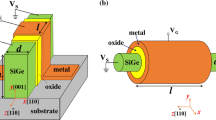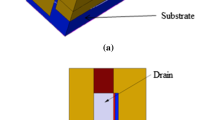Abstract
The performance of FinFET and FDSOI devices is compared by 3D Monte Carlo simulation using an enhanced quantum correction scheme. This scheme has two new features: (i) the quantum correction is extracted from a 2D cross-section of the 3D device and (ii) in addition to using a modified oxide permittivity and a modified work function in subthreshold, the work function is ramped above threshold to a different value in the on-state. This approach improves the accuracy of the quantum-correction for multi-gate devices and is shown to accurately reproduce 3D density-gradient simulation also at short channel lengths. 15 nm FDSOI device performance with thin box and back-gate bias is found to be competitive: compared to a FinFET with (110)/〈110〉 sidewall/channel orientation, the on-current for N-type devices is 25 % higher and the off-current is only increased by a factor of 2.5.






Similar content being viewed by others
References
Colinge, J.P.: Multi-gate SOI MOSFETs. Microelectron. Eng. 84, 2071–2076 (2007)
Planes, N., Weber, O., Barral, V., Haendler, S., Noblet, D., Croain, D., Bocat, M., Sassoulas, P.-O., Federspiel, X., Cros, A., Bajolet, A., Richard, E., Dumont, B., Perreau, P., Petit, D., Golanski, D., Fenouillet-Bérange, C., Guillot, N., Rafik, M., Huard, V., Puget, S., Montagner, X., Jaud, M.-A., Rozeau, O., Saxod, O., Wacquant, F., Monsieur, F., Barge, D., Pinzelli, L., Mellier, M., Boeuf, F., Arnaud, F., Haond, M.: 28nm FDSOI technology platform for high-speed low-voltage digital applications. In: Symp. on VLSI Tech., Honolulu, Hawaii, June 2012, pp. 133–134 (2012)
Basker, V.S., Standaert, T., Kawasaki, H., Yeh, C.-C., Maitra, K., Yamashita, T., Faltermeier, J., Adhikari, H., Jagannathan, H., Wang, J., Sunamura, H., Kanakasabapathy, S., Schmitz, S., Cummings, J., Inada, A., Lin, C.-H., Kulkarni, P., Zhu, Y., Kuss, J., Yamamoto, T., Kumar, A., Wahl, J., Yagishita, A., Edge, L.F., Kim, R.H., McIellan, E., Holmes, S.J., Johnson, R.C., Levin, T., Demarest, J., Hane, M., Takayanagi, M., Colburn, M., Paruchuri, V.K., Miller, R.J., Bu, H., Doris, B., McHerron, D., Leobandung, E., O’Neill, J.: A 0.063 μm2 FinFET SRAM cell demonstration with conventional lithography using a novel integration scheme with aggressively scaled fin and gate pitch. In: Symp. on VLSI Tech., Honolulu, Hawaii, June 2010, pp. 19–20 (2010)
Bufler, F.M., Heinz, F.O., Smith, L.: Efficient 3D Monte Carlo simulation of orientation and stress effects in FinFETs. In: Proc. SISPAD, Glasgow, UK, September 2013, pp. 172–175 (2013)
Fischetti, M.V., Laux, S.E.: Monte Carlo study of electron transport in silicon inversion layers. Phys. Rev. B 48(4), 2244–2274 (1993)
Jungemann, C., Emunds, A., Engl, W.L.: Simulation of linear and nonlinear electron transport in homogeneous silicon inversion layers. Solid-State Electron. 36, 1529–1540 (1993)
Saint-Martin, J., Bournel, A., Monsef, F., Chassat, C., Dollfus, P.: Multi sub-band Monte Carlo simulation of an ultra-thin double gate MOSFET with 2D electron gas. Semicond. Sci. Technol. 21, L29–L31 (2006)
Lucci, L., Palestri, P., Esseni, D., Bergagnini, L., Selmi, L.: Monte Carlo study of transport, quantization, and electron-gas degeneration in ultrathin SOI n-MOSFETs. IEEE Trans. Electron Devices 54, 1156–1164 (2007)
Sampedro, C., Gámiz, F., Godoy, A., Valin, R., Garcia-Loureiro, A., Ruiz, F.G.: Multi-subband Monte Carlo study of device orientation effects in ultra-short channel DGSOI. Solid-State Electron. 54, 131–136 (2010)
Winstead, B., Ravaioli, U.: A quantum correction based on Schrödinger equation applied to Monte Carlo device simulation. IEEE Trans. Electron Devices 50, 440–446 (2003)
Palestri, P., Eminente, S., Esseni, D., Fiegna, C., Sangiorgi, E., Selmi, L.: An improved semi-classical Monte-Carlo approach for nano-scale MOSFET simulation. Solid-State Electron. 49, 727–732 (2005)
Ghetti, A., Carnevale, G., Rideau, D.: Coupled mechanical and 3-D Monte Carlo simulation of silicon nanowire MOSFETs. IEEE Trans. Nanotechnol. 6, 659–666 (2007)
Mori, T., Azuma, Y., Tsuchiya, H., Miyoshi, T.: Comparative study on drive current of III–V semiconductor, Ge, and Si channel n-MOSFETs based on quantum-corrected Monte Carlo simulation. IEEE Trans. Nanotechnol. 7, 237–241 (2008)
Hudé, R., Villanueva, D., Clerc, R., Ghibaudo, G., Robilliart, E.: A simple approach to account for the impact of quantum confinement on the charge in semiclassical Monte Carlo simulations of bulk nMOSFETs. In: Proc. ULIS, Bologna, Italy, April 2005, pp. 159–162 (2005)
Bufler, F.M., Hudé, R., Erlebach, A.: On a simple and accurate quantum correction for Monte Carlo simulation. J. Comput. Electron. 5, 467–469 (2006)
Pham, A.T., Jungemann, C., Meinerzhagen, B.: Microscopic modeling of hole inversion layer mobility in unstrained and uniaxially stressed Si on arbitrarily oriented substrates. Solid-State Electron. 52, 1437–1442 (2008)
Bufler, F.M., Heinz, F.O., Tsibizov, A., Oulmane, M.: Simulation of 〈110〉 nMOSFETs with a tensile strained cap layer. ECS Trans. 16(10), 91–100 (2008)
Bufler, F.M., Erlebach, A., Oulmane, M.: Hole mobility model with silicon inversion layer symmetry and stress-dependent piezoconductance coefficients. IEEE Electron Device Lett. 30, 996–998 (2009)
Jacoboni, C., Reggiani, L.: The Monte Carlo method for the solution of charge transport in semiconductors with application to covalent materials. Rev. Mod. Phys. 55, 645–705 (1983)
Bufler, F.M., Meinerzhagen, B.: Hole transport in strained Si1−x Ge x alloys on Si1−y Ge y substrates. J. Appl. Phys. 84, 5597–5602 (1998)
Akarvardar, K., Young, C.D., Baykan, M.O., Ok, I., Ngai, T., Ang, K.-W., Rodgers, M.P., Gausepohl, S., Majhi, P., Hobbs, C., Kirsch, P.D., Jammy, R.: Impact of fin doping and gate stack on FinFET (110) and (100) electron and hole mobilities. IEEE Electron Device Lett. 33, 351–353 (2012)
Granzner, R., Polyakov, V.M., Schwierz, F., Kittler, M., Doll, T.: On the suitability of DD and HD models for the simulation of nanometer double-gate MOSFETs. Physica E 19, 33–38 (2003)
Bufler, F.M., Erlebach, A.: Monte Carlo simulation of the performance dependence on surface and channel orientation in scaled pFinFETs. In: Proc. ESSDERC, Montreux, Switzerland, September 2006, pp. 174–177 (2006)
Bufler, F.M., Keith, S., Meinerzhagen, B.: Anisotropic ballistic in-plane transport of electrons in strained Si. In: Proc. SISPAD, Leuven, Belgium, September 1998, pp. 239–242 (1998)
Acknowledgements
We would like to thank A. Erlebach and F.O. Heinz for useful discussions.
Author information
Authors and Affiliations
Corresponding author
Appendix: On the quantum correction method
Appendix: On the quantum correction method
In this appendix, we present more details on our quantum correction method. The quantum-mechanical reference in this work is the density-gradient approach. In the context of the quantum correction, the advantage of density-gradient simulation is that it is also possible to simulate the complete 3D device structure which allows to verify the accuracy of the quantum-corrected DD simulations by comparing the corresponding transfer characteristics at different gate lengths as is done in Fig. 4. The parameter of density-gradient simulation is the quantization mass. This mass changes with the crystallographic orientation of the gate interface. In the present work, values for (100), (110) and (111) surface orientations are considered and during device simulation always the value of the nearest surface is used. For example, the electron (hole) quantization masses for (110) and (100) surface orientations are 0.32 (0.91) and 0.92 (0.26) in units of the free electron mass, respectively (for electrons, always the quantization mass of the valley with the largest mass in surface direction is taken since it dominates the electron density).
The new values for effective oxide thickness and workfunction used as a quantum correction are extracted from 2D device simulations on a cross-section of the 3D device which is shown for the FinFET in Fig. 7. The interfacial oxide is divided into different regions for the top side and the two sidewalls and two different values for \(\mathrm{\epsilon}_{\mathrm{ox}}\) are used as resulting from the different crystallographic orientations. In the case of the N-type (P-type) FinFETs with (110) sidewall and (001) top side, the effective permittivity values are 2.83 (3.01) and 2.94 (2.68) in units of the vacuum permittivity instead of the original value of 3.9. In case of discrepancies in the sheet densities between density-gradient and quantum correction, a division into more regions could be considered, but the present results as in Fig. 3 suggest that this will probably not be necessary.
Electron density at a gate voltage of VGS=0.8 V according to 2D density-gradient simulation. The simulated structure was obtained by a vertical cut through the middle of the FinFET in Fig. 1. The gate stack consists of interfacial oxide, HfO2, titanium nitride and the gate contact line
When replacing density-gradient simulation by 2D Schrödinger-Poisson solutions on the cross-section in Fig. 7 as the quantum-mechanical reference, 3D MC simulation will still not explicitly use subbands, of course. However, the corresponding correction for threshold voltage and channel charge will accurately be taken into account and the comparison between density-gradient and quantum-corrected DD in Fig. 4 shows that the density profile itself is not important. The crystallographic orientation dependence of the surface mobility is not due to quantization, but originates from the boundary condition in the presence of a gate interface and is therefore captured both in semiclassical transport (via conservation of energy and parallel-momentum) and in quantum transport (via e.g. vanishing wave functions at the gate interface) [4].
Strain changes subband structure and population resulting from Schrödinger-Poisson solutions, but the corresponding change in threshold voltage and channel charge is captured in our quantum correction approach analogously to the unstrained case. Concerning surface mobility, the strain-induced change in the bulk band structure changes the effect of energy and parallel-momentum conservation leading to a similar stress response as subband models (see Fig. 3 of Ref. [4]).
Rights and permissions
About this article
Cite this article
Bufler, F.M., Smith, L. 3D Monte Carlo simulation of FinFET and FDSOI devices with accurate quantum correction. J Comput Electron 12, 651–657 (2013). https://doi.org/10.1007/s10825-013-0518-z
Published:
Issue Date:
DOI: https://doi.org/10.1007/s10825-013-0518-z





